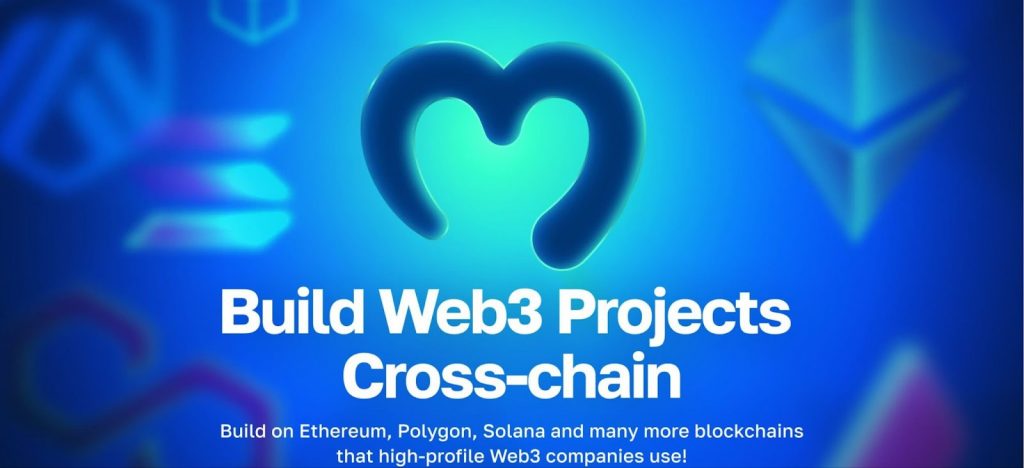Ethereum is undoubtedly the premier blockchain for smart contracts and dapp development. Yet, the well-known scalability challenges it faces, leading to increased transaction costs, have prompted Web3 developers to explore alternatives. Cosmos emerges as a compelling option in response to these issues. But what exactly is Cosmos? Also, what are some of the best Cosmos projects? If you’d like to explore Cosmos further, join us in this article as we dive into the intricacies of the Cosmos ecosystem!
Overview: Cosmos Ecosystem – Exploring the Best Projects
In today’s article, we’ll kick things off by diving straight into the Cosmos ecosystem. In doing so, we’ll explain what Cosmos is, how it works, and cover some prominent benefits of using this network. From there, we’ll explore seven of the best projects on Cosmos, briefly covering platforms like Akash, Osmosis, Keplr, etc. Lastly, for those interested in Web3 development, we’ll introduce you to the industry’s leading Web3 API provider: Moralis!
In Moralis’ comprehensive suite of APIs, you’ll find more than ten APIs for various use cases, including the NFT API, Wallet API, Token API, and many others. As such, it doesn’t matter if you’re looking to build an NFT marketplace, decentralized exchange (DEX), crypto portfolio tracker, or any other Web3 platform; Moralis has got you covered.
Our premier Web3 APIs at Moralis are designed for optimal performance, boasting industry-leading response times and seamless cross-chain compatibility. By leveraging our APIs, you can significantly expedite your project launch timeline, reducing it by an impressive 83% on average. So, when using Moralis, you can build projects both smarter and faster.
Also, did you know you can access our APIs for free? Simply sign up with Moralis, and you’ll be able to start building dapps faster and more efficiently!
Now, without further ado, let’s dive straight into the ins and outs of the Cosmos ecosystem!
What is the Cosmos Ecosystem?
The Cosmos ecosystem is a groundbreaking decentralized network. It unites multiple independent chains into a cohesive ”internet of blockchains” or ”Interchain”. Together, these blockchains host an expansive and dynamic ecosystem comprising approximately 250 dapps. These projects collectively manage digital assets worth over $66 billion, underscoring the substantial economic activity and value within the Cosmos ecosystem!

At the center of Cosmos’ approach is the vision of a substantial, interconnected system of blockchains, each with a unique design to serve a particular use case. To enable this, Cosmos provides tools that allow developers to create their own application-specific blockchains. In doing so, they can bypass common challenges associated with conventional networks, such as high transaction fees, network congestion, etc.
This potentially marks a paradigm shift from the traditional model, where millions of blockchain applications compete for throughput on a single base layer. In comparison, Cosmos aspires to cultivate an ecosystem where millions of applications are distributed across millions of independent yet interconnected blockchains.
All in all, the Cosmos ecosystem is an innovative distributed network that unites several independent chains into an ”internet of blockchains” or ”Interchain”!
For similar articles exploring other Web3 ecosystems, read our Solana ecosystem guide or dive into the Ethereum ecosystem in 2024.
How Does the Cosmos Ecosystem Work?
At the center of the Cosmos ecosystem, you’ll find three core technologies that allow developers to seamlessly build application-specific blockchains:
CometBFT: CometBFT is a state machine replication engine for secure, reliable, large-scale, application-specific blockchains. Essentially, it’s software for consistently and securely replicating an application on multiple machines. Cosmos Software Development Kit (SDK): The Cosmos SDK is a generalized framework comprising various robust tools for building projects on Cosmos. As such, building dapps for the network becomes more intuitive when working with the Cosmos SDK. Inter-Blockchain Communication Protocol (IBC): IBC is the standard protocol that allows blockchains in the Cosmos ecosystem to connect with one another, enabling them to transfer tokens and data in a frictionless and seamless manner.

What is Cosmos Hub?
At the heart of the Cosmos ecosystem, you’ll find Cosmos Hub serving as the economic center of Interchain. Furthermore, Cosmos Hub is the first blockchain to launch on the network, and it supplies the ecosystem with a few vital services:
Marketplace: Cosmos Hub serves as a next-gen decentralized exchange (DEX) for swapping cryptocurrencies with low fees and instantaneous transaction confirmations. Security Provider: With upcoming security features, the ATOM token (read about ATOM below) will soon secure several chains in exchange for additional staking rewards. Router: Cosmos Hub also establishes IBC connections between chains and operates bridges with networks like Ethereum and Binance. Custodian: Cosmos Hub is located at the center of the ecosystem, and it’s highly secure, making it the best place to hold digital assets and manage accounts across several chains.

What is ATOM?
ATOM is the native cryptocurrency of Cosmos Hub, and it has a lot of utility within the ecosystem. Apart from acting as a medium of exchange, ATOM is also used to pay transaction fees on Cosmos. The ATOM token can also be staked, which is how the network is kept secure. In return for staking, stakers earn rewards based on the amount they lock up.
Benefits of the Cosmos Ecosystem
The Cosmos ecosystem has several prominent benefits, and in this section, we’ll explore five examples:
Scalability: Cosmos offers high scalability by allowing you and other developers to seamlessly duplicate blockchains to relieve congestion or divide dapps into several application-specific chains. This is a valuable solution for tackling the scalability challenges that competing networks, such as Ethereum, often face. Usability: The Cosmos SDK simplifies the process of Web3 development, reducing the time and effort required to build projects for the Cosmos ecosystem. Low Fees: Cosmos boasts transaction fees of less than $0.01, making the ecosystem a more economically viable option compared to many competing chains. This can be beneficial for projects relying on high throughput, such as DeFi platforms or Web3 games. Established Ecosystem: Cosmos hosts a vast ecosystem that’s growing larger every day. In fact, the network features 250+ dapps, including NFT marketplaces, DeFi platforms, and other prominent projects. This means that Cosmos already has an established user base from which you can attract customers to your projects. Cross-Chain Apps: Thanks to the IBC protocol, it’s possible for you and other developers to create cross-chain compatible applications that combine the strengths of multiple networks.

Cosmos Ecosystem Use Cases
With Cosmos, you can seamlessly set up networks optimized for various use cases. Below, you’ll find five prominent examples:
Decentralized Finance (DeFi) Platforms: Build exchanges and marketplaces that allow people worldwide to buy, sell, trade, invest, and lend – even without having a bank account. Decentralized Organizations: Create applications and other platforms where the community and token holders have the power to allocate and organize resources. Healthcare: Build healthcare platforms where users maintain control of personal health data through a fine-grain permission system. Only authorized healthcare providers that you approve can access the information. Game Economies: The Cosmos ecosystem allows for the creation of unique collectibles and character upgrades you can monetize without any intermediary involvement. This lays a solid foundation for building sophisticated Web3 gaming economies. NFT Marketplaces: Build NFT marketplaces on Cosmos where users can buy, sell, trade, and even mint NFTs.

That covers five prominent use cases of Cosmos. In the next section, we’ll dive into some of the best Cosmos projects to explore the ecosystem further!
List of the Best Cosmos Projects
With an overview of Cosmos, let’s explore some of the best projects within the ecosystem. More specifically, we’ll look at seven leading platforms:
If you’d like to explore other projects not covered above, check out our complete list of top Cosmos dapps on Moralis’ dapp store!
Introducing Moralis: The Easiest Way to Build Web3 Projects
Now, with an overview of the best projects on Cosmos, you might feel inspired to start building your own Web3 platforms. If this is the case, then join us in this section as we introduce you to Moralis!
Moralis is the industry’s leading Web3 API provider, and our premier APIs currently power blockchain applications for millions and millions of end users worldwide!

In Moralis’ suite of tools, you’ll find more than ten APIs for various use cases. This includes the NFT API, Wallet API, Token API, and many others. These tools allow you to seamlessly query and integrate any on-chain data into your projects with only single lines of code. Consequently, when working with Moralis, you can build everything from DEXs to cryptocurrency wallets without breaking a sweat.
To further highlight the power of Moralis, let’s look at three benefits of using our APIs:
Comprehensive: We enrich all our API responses with market data, address labels, metadata, transaction decodings, etc., from multiple sources – all to create the industry’s most comprehensive APIs. Trusted: Moralis’ Web3 APIs are trusted by hundreds of thousands of developers and major enterprise customers. For example, the Web3 APIs from Moralis are trusted by MetaMask, Polygon, Delta, and others. Cross-Chain Compatible: Our APIs are cross-chain compatible. This allows you to build dapps (decentralized applications) seamlessly for multiple networks. This includes Ethereum, Cronos, BNB Smart Chain (BSC), Polygon, etc.
Here are three examples of our prominent APIs you’ll likely find helpful in your development endeavors:
If you want to explore all our development tools, please check out the official Web3 API page! Also, did you know you can access our APIs for free? Just sign up with Moralis, and you’re ready to go!
Summary: Exploring the Cosmos Ecosystem – List of the Best Cosmos Projects
In today’s article, we kicked things off by exploring the Cosmos ecosystem. In doing so, we learned that it’s a groundbreaking network that unites multiple independent chains into an ”internet of blockchains” or ”Interchain”. The chains in the network host a vast ecosystem of about 250 dapps, and together, these projects manage assets worth over $66 billion!

From there, we also covered how the ecosystem works, where we briefly dove into the following three technologies: CometBFT, Cosmos SDK, and the IBC protocol. Next, we additionally explored Cosmos Hub, along with benefits and use cases for the Cosmos ecosystem.
After exploring Cosmos, we also covered seven of the ecosystem’s best projects:
AkashFetch.ai StargazeOsmosisDYdXKeplrMonsterra
To top things off, we introduced you to the industry’s leading Web3 API provider: Moralis!
In Moralis’ premier suite of Web3 APIs, you’ll find prominent interfaces like the NFT API, Token API, Wallet API, and many others. With these tools, you can easily build everything from NFT marketplaces to DEXs without breaking a sweat. What’s more, thanks to the power and accessibility of Moralis, you can minimize your project launch timeline, reducing it by a staggering 83% on average. Consequently, when working with our APIs, you can build dapps faster and more efficiently!
If you liked this Cosmos ecosystem guide, consider checking out more premier content here at the Web3 blog. For example, read about the Why Did It Move API, which lets you provide answers to questions like “Why did crypto go up today?” and “Why crypto is up or down?” to your dapp’s users!
If you want to take your Web3 projects to the next level, don’t forget to sign up with Moralis. You can create an account for free, and you’ll get instant access to our industry-leading Web3 APIs!





















